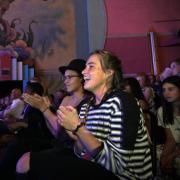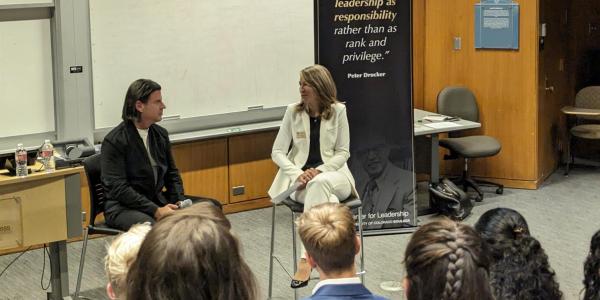
While plaid and shearling were all the buzz on the fall 2017 fashion runways in New York and Milan earlier this year, Boulder took a different approach to fashion trends: promoting climate communication on the catwalk. Enter chicken wire, plastic bags and rubber bike tires transformed into artful expressions that lend themselves to the discussion of growing environmental concern.
This was at Recycled Runway—a visionary event hosted by The Common Threads Creative Lab and in collaboration with community partners, including CU Boulder. Tuesday, April 18, saw the eighth annual runway show, where CU Boulder students partnered with middle and high school students across Boulder County to share the story of sustainability. The Recycled Runway designers were challenged to create fashion couture made solely of recycled materials.
Utilizing art forms to convey messages of sustainability is really important because with art, you’re allowed to create your own opinions about things.”
CU students were there to document the creative process as a part of CU Boulder’s Creative Climate Communications class, an ATLAS course taught by Associate Professor Max Boykoff (Environmental Studies and CIRES) and Associate Professor Beth Osnes (Department of Theatre and Dance). The course challenges students to communicate heavy, and often controversial, topics such as climate change. The Recycled Runway project, in particular, teaches CU students the value of visual communication via video documentation, as each student chronicled the creative journey of the Recycled Runway designers.
“Connecting students from the Creative Climate Communications class with Recycled Runway designers helps everyone involved to connect fashion with considerations of climate and environmental impact through these creative works,” Boykoff says.
Aside from an evening of avant-garde design and effective environmental messaging, this year’s event also helped youth in crisis. All of the proceeds from the event were donated to Attention Homes, an organization working to provide life-changing resources such as behavioral, emotional and career-related support to young people.
Unlike most fashion runways, Recycled Runway is impact-centric. But in a sense, Recycled Runway is similar to the high-end fashion system in general. Haute couture originally served as inspiration for the ready-to-wear fashion that would follow—permeating the entire fashion hierarchy and influencing fashion trends designed for the general public. For Recycled Runway, instead of the color, cut or style influencing trends, the goal is to affect ways of thinking—sharing a message that could permeate thoughts and actions. The message has even more impact since it is conveyed through a commodity familiar to everyone: clothing.
Fashion itself is reportedly a toxic business, considered one of the more polluting industries in the world. Sharing sustainable messages in this field could be highly valuable. However, beyond the fashion industry itself is the opportunity to teach young people how to communicate important, controversial topics in a way that has social impact.
CU Boulder student Jesyca Lazo, who worked with classmate Erica Nied in an observant role documenting all of the designers behind the scenes, finds the most intriguing aspect of artful communication to be the value of implicit messaging.
“Utilizing art forms to convey messages of sustainability is really important because with art, you’re allowed to create your own opinions about things,” Lazo said. “The audience has the ability to interpret the art the way that they want to, and that could be either good or bad, but at least it reduces bias.”
However, unlike the ephemeral effect of many fashion runways that trend for only six months, the impact of creating the Recycled Runway experience can be life-altering. Documenting a creative process focused on sustainability can give the middle and high school students an opportunity to internalize and revisit their work with environmental messaging.
Andrew Taylor-Shaut, a CU Boulder senior, reflects on his experience documenting the designers.
“During the process, the students are so in the moment with designing, and hopefully, with these videos, they can take a step back and see what they’ve actually produced and the impact of what they’ve done,” he said. “That’s kind of the point of what we’re doing.”







